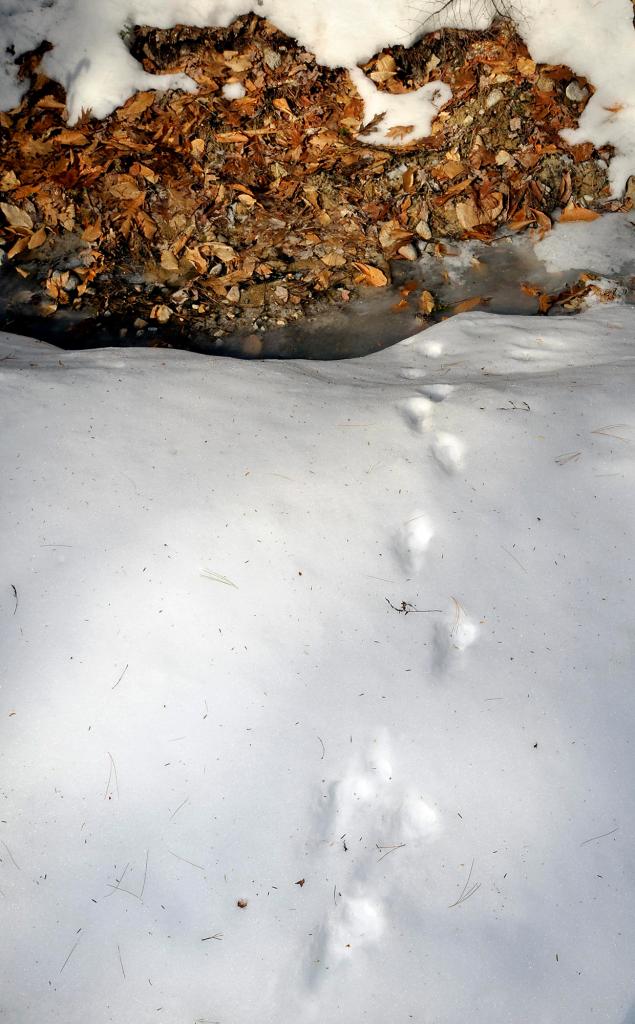BRIDGTON – If someone offered to set up motion-detector cameras to reveal the myriad of critters that live and travel around your home, wouldn’t you let them? Wouldn’t it be fun to know?
There are definitely more than you think.
The truth is anyone can figure this out without high-tech gear or much trouble. All that’s needed is some basic know-how, a little old-fashioned effort, and OK, some snow.
Snow may be a lot to ask for in some parts of Maine this year, but with a good two more weeks of winter (at least on the calendar) there’s a fair chance another dusting will help display a landscape of lines, patterns and prints. And all those critters running around your home will leave tracks in the snow.
One upcoming seminar on this ancient practice of reading animal tracks at the Lakes Environmental Association in Bridgton can help a novice tracker get started. It’s not exactly straightforward, but once taught the basics, it’s not so tough.
The association’s environmental educator, Bridie McGreavy, compares it to translating a foreign language.
There are basic signs that help zero in on whether a track is from a large or small mammal or a wild or domestic animal. Then, as McGreavy demonstrated at a seminar at the association’s Holt Pond Preserve, there are an infinite number of clues that tell the stories of these busy travelers.
She stopped at one set of small tracks and quickly measured the stride, determining the 13- to 14-inch stride meant it was a relatively small mammal.
It clearly was a member of the dog family because the shape of the pawprint resembled an “X.”
Given there were four toe prints, McGreavy decided it was a fox. But determining whether red or gray required more thought. The investigation continued.
McGreavy got down and took a whiff to find out if it had a skunk or feline odor.
“I’ve done that with what I thought were dog tracks and had it be a bobcat because of the cat smell,” she said.
The smell of the urine mark is a tell-tale sign in this case, since red foxes are known to leave a stinky scent, and this smell was, indeed, strong and pungent.
But there is one more clue that leaves McGreavy positive she’s identified the critter.
“The fuzziness of the track is the clue, because red (ones) have fur on the bottom of their feet,” she says, documenting it in her journal.
Leigh Hayes of Bridgton has joined McGreavy in the past and improved her ability at identifying raccoon, fox and squirrel tracks. But Hayes still is amazed at the methodical way McGreavy deduces the tracks she finds in the snow.
“She’s good,” said the Bridgton naturalist shaking her head.
This day, McGreavy walked with four novice trackers who included Hayes and studied about a half-dozen tracks. On all but the obvious deer track McGreavy had to lead the group through the identification process step by step.
On each track McGreavy considers where it is found, the size, gait, the measurement between the back legs and the front, and even the smell.
“It’s like being with a forensic detective,” said Derby Cartmill of Casco as he followed along through the woods.
McGreavy helps show clues are everywhere, once a woods walker begins looking for them. And the more clues that are found, the easier the task becomes.
Deer prints are everywhere in Maine, along with those dog-like coyote tracks. And more north, of course, the unmistakable deep dent of a moose print is easy to find.
But it’s not uncommon to see black bear tracks, even in the winter, right in southern Maine. An enormous pie-shaped paw dent was recently seen in the snow crust in the woods of Kennebunkport.
And smaller mammals are found statewide, too, like bobcats, red and gray foxes, fishers and raccoons and cautious snowshoe hares. Our state’s also got opossums, skunks, woodchucks and turkeys. And around bog land and marshes, there are muskrats, minks and otters.
With so many small mammals here it’s easy to miss a clue when tracking and think the print says one thing when it really says something else.
“The big challenge is with the weasel family, because the males are bigger than the females and overlap in size,” McGreavy pointed out while studying a set of tracks along a small stream bed.
“So the female otter is the same size as the male fisher; the female fisher is the same size as the male marten; and the female mink is the same size as the male weasel. You can’t be a 100 percent confident with a weasel.”
Definitely two sets of tracks running side by side can be deceiving – like two words of a foreign language that look the same.
But even in moments of confusion, McGreavy’s got tricks to help track.
“When in doubt, follow it out. That’s part of the language of tracking,” she says.
Staff Writer Deirdre Fleming can be contacted at 791-6452 or at:
dfleming@pressherald.com
Send questions/comments to the editors.








Comments are no longer available on this story